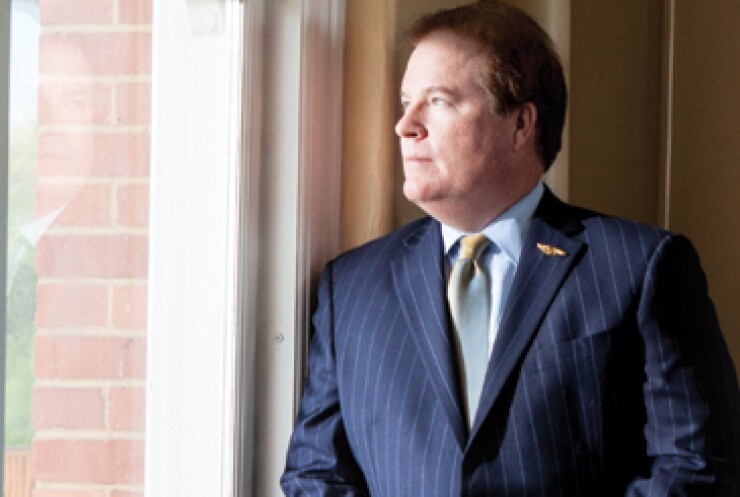Steve Calk sees things differently than the typical bank CEO.
While many depositories do just enough mortgage lending to low- to moderate-income borrowers to meet statutory requirements, Calk has made it the backbone for growth at The Federal Savings Bank.
The strategy is paying off. The Chicago-based thrift had a three-year average return on equity of 46.36% through 2014, making it the top performer among nearly 5,000 public and private financial institutions with less than $2 billion in assets. Its next closest peer has a three-year ROE of 34.62%, according to NMN

Depository lenders that cherry-pick loans made to higher-income borrowers and only engage in enough low-mod lending to fulfill Community Reinvestment Act requirements justify their concerns by citing the severe risks of

Community banks have stepped in to fill the void, but the specialized operations needed deter even some of them. There also are independent mortgage companies with an interest in serving consumers with affordable housing needs, but these usually are nonbanks that lack the ability to portfolio loans.
The privately held TFSB, meanwhile, engages in lending to urban borrowers with more modest incomes to an extent above and beyond what the CRA requires, says Calk. As a depository with a national reach, it has the ability to hold some loans in portfolio to accommodate a wider range of borrowers.
Thrifts historically have focused on consumer loans, but the lines between them and commercial banks have blurred, and they aren't typically national institutions.
This suggests the bank has found some niches with good returns somewhere in between the territories staked out by other types of lenders, and the story of its origin suggests that it has been able to do this because it has learned some lessons from walking a few miles in their shoes.
The national depository started as a local, family-run, independent mortgage bank; and as anyone familiar with the tension between bank and nonbank mortgage cultures might guess, the transition between the two business models wasn't an easy one.
Calk regrets that to this day, but he says it was a necessary response to changes in the market and the regulatory environment at the time.
The resulting institution devotes attention to diverse affordability and niche borrowers in metropolitan areas the way an independent mortgage banker would, but it also has a bank's broader resources, business lines and operations.
This has fueled TFSB strong returns, but in a measured way that reflects discipline in its principals learned while they were in the military, according to Calk. He says that's how his bank can profit from having a higher low-mod lending concentration than others.
"We get up every day and try to hit a base hit," he says.
The 'Secret Sauce'
The Federal Savings Bank's approach to lending is more about moving forward one step at a time than "swinging for the fences," Calk says.
The bank's returns are aggressive relative to peers of its asset size and it can be innovative in its willingness to, for example, experiment with unsecured "marketplace" loans for veterans; but most of its mortgage originations are more established home loan products that it sells to the secondary market.
Roughly 90% of the bank's lending is in the single-family space, and the Department of Veterans Affairs insures more than half of the mortgages that the veteran-owned bank originates.
The bank is well-versed in the procedures needed to help borrowers get VA loans, says Dell Dailey, a retired Army general and former ambassador at large for the State Department. He was pleasantly surprised bank Senior Vice President Brad Berndt, for example, knew how to restore — and was proactive about restoring — Dailey's VA entitlement after Dailey had paid off his first VA loan and applied to get a new one for a retirement home.
"He got all that confirmation," he says. "I thought anybody else would say, 'Dailey, you've got to go do it yourself.'"
Only about 10% of TFSB's production is jumbo loans and the remainder consists mostly of government and agency products.
While Calk says he would like to diversify further, he does not want to dilute the bank's core strengths as a low-mod, single-family mortgage lender too much.
Established forms of low-mod lending fit in with the bank's goal of "one base hit at a time" growth because borrowers in these categories tend to be people who don't have a lot of money to immediately spend on financial services at the outset, but their net worth has the potential to increase slowly over time.
"I think the real secret sauce is not treating a small-balance loan, first-time homebuyer as a commodity," says Calk.
The potential for slow wealth-building through low-mod lending not only has benefits in terms of its cross-selling appeal and because it's a form of community reinvestment the government supports, but also because these consumers take longer to pay off their loans, unlike wealthier ones who prepay.
"The servicing value of those loans is a lot higher," says Rick Roque, a Boston area industry consultant who advises mortgage-related companies on mergers, acquisitions and other types of growth strategies.
Despite this attraction, the latest available Home Mortgage Disclosure Act numbers show the average share of loans lenders have been making to borrowers with low-mod incomes has fallen closer to levels representing around one-fourth of overall industry volume from levels closer to a one-third share.
That's probably because there are challenges involved in originating low-mod mortgages that have to be weighed against their rewards, Roque says.
"I think there are a couple of strong benefits but then there are risks," he says.
Low-Mod's Tradeoffs
Large lenders have been
The FHA is not the only low-mod lending source but it tends to be the go-to one because it has historically made more accommodations for these borrowers and tends to be the most affordable option, even with competing agency loans' flexibility increasing in areas like down-payment requirements, Roque says.
Also, agency loans have their own risks. Fannie Mae or Freddie Mac can try to get lenders to repurchase them on the grounds of origination flaws.
In addition to agency and FHA loans, the VA loans The Federal Savings Bank specializes in also can be a good fit for low-mod borrowers who qualify. These government-insured loans don't, for example, technically have a loan-to-value ratio limit.
However, VA loans involve a more thorough test of borrowers' incomes and spending ability than most other common loan options, and only certain consumers are eligible for them. Also the insurance covers 25% of the loan amount in many cases, leaving lenders exposed to the remaining risk.
VA lending nevertheless has grown in popularity. HMDA data analyzed by Mortgage TrueView suggests that the VA share of lending overall does seem to have grown between 2010 and 2014 to almost 9% from closer to 4%, while the percentage of lending in the FHA space has fallen to around 16% from 23%.
"When focusing on the top 10 lenders by volume, the percentage of FHA lending has shrunk significantly," says Rebecca Walzak, a mortgage industry consultant who has worked with the risk management and analytics provider.
It's possible when the 2015 HMDA data comes in it will show some growth in FHA share since the insurance arm of the Department of Housing and Urban Development did lower premiums during the year in a way that made the loans more attractive.
Both the HUD and the agencies have worked to address liability concerns and be more lender-friendly in the past year, but lenders remain wary of the risks associated with government-insured loans, which go to borrowers with lower average credit scores.
"Most lenders do try to cherry-pick the prime borrowers," says Roque.
Calk indicated he has a good working relationship with FHA and noted that VA "has proven to be a strong product and a profitable product."
But he also noted that "the repercussions even for what appears to be a safe-and-sound lending decision at that time could literally cost you the ability to do government lending and that's a risk we evaluate every day very, very carefully."
Potential liabilities aren't the only reason government lending can be a challenge, there are some specific hurdles for banks versus nonbanks, Roque says.
Nonbanks may be more focused on home lending only and as such can be better equipped to put in the time and make the investment in operations needed to handle specialized government products like FHA, VA or Rural Housing Service loans.
Nonbanks give banks a run for their money when it comes to home loans, but banks have become more competitive in the past year, according to a recent survey by Accenture. Less than half of U.S. borrowers get mortgages from their primary bank; the percentage of consumers who do rose to 45% to 37% in the past year.
"The problem is most depositories really are not set up for mortgage lending," says Roque, although he notes that some have their specialties.
"Every bank has its sort of niche," he says. "I have one client on the West Coast whose niche is jumbo and condos. That's just what they know. A lot of lenders will stay very far away from jumbos and condos."
While nonbanks might have the specialized resources and culture needed to handle single-family lending and all its nuances, they can't portfolio loans or build capital the way a bank can.
"It all ends up opening up a significant opportunity for lenders that want to take [low-mod lending] risk," Roque says. "They'll capitalize for that risk and they will go after those markets."
The bank also works to maintain a strong relationship with its regulator, the Office of the Comptroller of the Currency, and to ensure that it is adequately capitalized for any risk that it takes on, says Calk.
The bank's emphasis on careful growth is clearly part of what has driven its ROE over time, but the development of technology-driven efficiencies also have factored into the equation.
A Proving Ground
The Federal Savings Bank since the early days of the loan origination system has been eager to participate in trying out and discussing new forms of automation, says Jonathan Corr, president and CEO of mortgage technology vendor Ellie Mae.
"They are never sitting still," he says.
In addition to being active in technology development, the bank has been working with smaller vendors who can introduce new accuracy and efficiencies, says Steve Calk's brother and bank vice chair John Calk, who serves as the point person on these initiatives.
"Residential mortgages have become really complicated. We're really trying to recognize the reality that we need people involved in the process, but also look at how do you take days out of the process?" John Calk says.
In addition to using technology to become more efficient, the bank has roughly halved its defect rate over time, says John Calk, who previously worked for GE Capital, a company known for its advocacy of the Six Sigma error reduction methodology.
"Their loans are very well put together and well documented," says A.J. George, a senior vice president in CMG Financial's correspondent loan-buying channel.
As Six Sigma methodology acknowledges, a zero defect rate is impossible. But Steve Calk says that while his bank has had to deal with its share of challenges in the past, it keep trying to do its best to minimize such concerns as it continues to grow.
"I just get up every day and go to work and try to make as few mistakes as I can," Steve Calk says.
Safe-and-sound lending doesn't have to be risk-free, but any risks taken have to be carefully sized up and controlled, he says.
"You just have to understand what that risk looks like," says Steve Calk.





